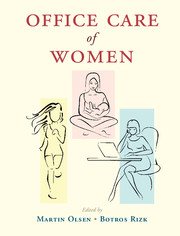Book contents
- Office Care of Women
- Office Care of Women
- Copyright page
- Dedication
- Contents
- Contributors
- Preface
- Section I Health promotion
- Section II Office interventions
- Section III Pregnancy
- Section IV Gynecology
- Section V Reproductive endocrinology and infertility
- Section VI Nongynecologic conditions
- Index
- References
Section V - Reproductive endocrinology and infertility
Published online by Cambridge University Press: 05 May 2016
- Office Care of Women
- Office Care of Women
- Copyright page
- Dedication
- Contents
- Contributors
- Preface
- Section I Health promotion
- Section II Office interventions
- Section III Pregnancy
- Section IV Gynecology
- Section V Reproductive endocrinology and infertility
- Section VI Nongynecologic conditions
- Index
- References
- Type
- Chapter
- Information
- Office Care of Women , pp. 285 - 366Publisher: Cambridge University PressPrint publication year: 2016



